Measurement of Rock Electrical Parameters and Analysis of Influencing Factors of Quaternary Mudstone Biogas Reservoirs in Qaidam Basin
Abstract
:1. Introduction
2. Sample Preparation and Experimental Methods
2.1. Experimental Samples
2.2. Preliminary Experiments for Rock Electrical Parameter Measurement of Biogas Reservoirs
2.3. “Self-Absorption Water Augmentation Method” for Rock Electrical Parameter Measurement
- (1)
- Core conformation pretreatment: The experimental core sample was cut to the design size by wire-electrode cutting to ensure the end face was flat (Figure 2a). At the same time, in order to prevent the core sample from softening and cracking, a highly temperature-resistant, heat-shrinkable sleeve was used to wrap it (the surrounding surface of the core sample was wrapped, and the two ends were exposed) in order to support and protect the core sample and ensure the integrity of the core sample in the subsequent experiment process (Figure 2b).
- (2)
- Measurement of rock electrical parameters: The water saturation of the core sample was controlled using the capillary self-absorption method, and the resistivity measurement of the core sample was conducted under different water saturation states.
3. Experimental Results
3.1. Relationship between Formation Factors and Porosity
3.2. Relationship between Resistivity Index and Water Saturation
3.3. Cementation Index m and Saturation Index n
4. Discussion and Analysis
4.1. Influence of Lithology on Rock Electrical Parameters
4.2. Influence of Physical Properties on Rock Electrical Parameters
4.3. Influence of Organic Matter Content on Rock Electrical Parameters
5. Conclusions
- (1)
- The core samples of the Quaternary mudstone biogas reservoir in Qaidam Basin generally had a porosity greater than 20% and a permeability between 0.05–5 mD. The rock mineral composition was dominated by clay minerals, followed by carbonate minerals, quartz, and feldspar. The clay mineral composition was mainly illite, followed by montmorillonite and chlorite, with a small amount of kaolinite. The rock was weakly cemented, high in clay, and easy to hydrolyze. It would have been impossible to complete the rock electrical experiment and obtain the rock electrical parameters based on existing industry standard methods.
- (2)
- The use of wire-electrode cutting and high-temperature heat-shrinkable tube to wrap the core sample supported and protected the core sample. The rock resistivity was measured by the self-absorption water augmentation method to obtain the rock electrical parameters of the core samples. The cementation index m of the core samples was in the range of 1.89–2.08, with an average value of 1.99, while the saturation index n was in the range of 1.872–2.270, with an average value of 2.09.
- (3)
- The rock electrical parameters of the reservoir core samples were affected by lithology and physical properties, but not significantly influenced by organic matter content. The cementation index increased with the decreasing clay mineral content, increasing quartz content, and increasing permeability, while the saturation index increased with the decreasing clay mineral content, increasing quartz content, and increasing permeability.
Author Contributions
Funding
Data Availability Statement
Conflicts of Interest
References
- Shurr, G.W.; Ridgley, J.L. Unconventional shallow biogenic gas systems. AAPG Bull. 2002, 86, 1939–1969. [Google Scholar]
- Zhang, Y.G.; Chen, H.J. Concepts on the generation and accumulation of biogenic gas. Oil Gas Geol. 1983, 2, 160–170. (In Chinese) [Google Scholar]
- Garcia-Gil, S.; Vilas, F.; Garcia-Garcia, A. Shallow gas feature in incised-valley fills (Ria de Vigo NW Spain): A case study. Cont. Shelf Res. 2002, 22, 2303–2315. [Google Scholar] [CrossRef]
- Rice, D.D.; Claypool, G.E. Generation, accumulation, and resource potential of biogenic gas. AAPG Bull. 1981, 65, 5–25. [Google Scholar]
- Xin, B.-X.; Chen, Y. Formation Mechanism and Exploration Potential of Biogenic Gases. Contemp. Chem. Ind. 2018, 47, 1928–1931. (In Chinese) [Google Scholar]
- Norville, G.A.; Dawe, R.A. Carbon and hydrogen isotopic variations of natural gases in the southeast Columbus basin offshore southeastern Trinidad, West Indies–clues to origin and maturity. Appl. Geochem. 2007, 22, 2086–2094. [Google Scholar] [CrossRef]
- Petro China Qinghai Oilfield Company. Petroleum Resource Evaluation in Qaidam Basin; Petro China Qinghai Oilfield Company: Dunhuang, China, 2002. (In Chinese) [Google Scholar]
- Wei, G.; Liu, D. Formation mechanism, distribution feature and exploration prospect of the Quaternary biogenic gas in Qaidam Basin, NW China. Pet. Explor. Dev. 2005, 32, 84–89. (In Chinese) [Google Scholar]
- Dang, Y.; Zhang, D.; Xu, Z.; Hou, Z. Sedimentary facies and biogenicgas pool of the Quaternary of Sanhu area in Qaidam Basin. J. Palaeogeogr. 2004, 6, 110–118. (In Chinese) [Google Scholar]
- Xu, Z. Practice and Reflection on Biogas Exploration in Eastern Qaidam Basin. China Pet. Explor. 2006, 11, 33–37. (In Chinese) [Google Scholar]
- Song, N. Biogenic gas generation model and source rock evaluation in Sanhu area of Qaidam Basin. Master’s Thesis, Yangtze University, Jingzhou, China, 2012. (In Chinese). [Google Scholar]
- Li, B.; Wang, M.; Wei, G.; Zhang, D.; Wang, J. Lateral Migration and Accumulation of Biogenic Gas in the Sanhu Area, Qaidam Basin. Geol. Rev. 2003, 49, 93–100. (In Chinese) [Google Scholar]
- Tang, X.; Jiang, Z.; Shao, Z.; Long, G.; He, S.; Liu, X.; Wang, Y. Reservoir Characteristics and Dynamic Accumulation Process of the Quaternary Mudstone Biogas. Geoscience 2022, 36, 682–694. [Google Scholar]
- Guan, Z.; Xu, Z. The Essential Conditions and Controlling Factors of Formation of Quaternary Biogenic Gas Reservoirs. Nat. Gas Ind. 2001, 21, 1–5. (In Chinese) [Google Scholar]
- Archie, G.E. The electrical resistivity log as an aid in determining some reservoir characteristics. Trans. Aime 1942, 146, 54–62. [Google Scholar] [CrossRef]
- Rickman, R.; Mullen, M.; Petre, E.; Grieser, B.; Kundert, D. A Practical Use of Shale Petrophysics for Stimulation Design Optimization: All Shale Plays Are Not Clones of the Barnett Shale. In Proceedings of the SPE Annual Technical Conference & Exhibition, Denver, CO, USA, 21 September 2008; Society of Petroleum Engineers: Houston, TX, USA. [Google Scholar]
- Xiao, Z.; Zhu, S.; Ma, J.; Wang, D.; Wang, Z.; Min, Z.; Sang, J. Influence of dispersion character of rock electric parameter on Archie′s formulas and Waxman-Smits model. Oil Geophys. Prospect. 2009, 44, 248–251. (In Chinese) [Google Scholar]
- Simandoux, P. Measures dielectrique en milieu poreux, application a mesure de saturation en eau, etude des massifs argileaux. Rev. De L’Institut Fr. Du Pet. 1963, Supplementary Issue, 193–215. [Google Scholar]
- Li, G.; Zhang, J.; Hu, Y.; Yu-lin, C. Relationship between porosity-resistivity and the methods of formation factor calculation in tight sandstone. Prog. Geophys. 2016, 31, 695–700. (In Chinese) [Google Scholar]
- Li, L.; Hongxin, Z.; Lingyuan, M. Technique of laboratory measurement of rock resistivity parameters in low permeability sandstone reservoir. Pet. Geol. Recovery Effic. 2018, 25, 106–111. (In Chinese) [Google Scholar] [CrossRef]
- Zhou, G.Y.; Liu, X.J. Experimental Research of Rock Electrical Parameters for Tight Sandstone. Sci. Technol. Rev. 2011, 29, 38–41. (In Chinese) [Google Scholar]
- Liu, X.; Hong, L.; Chao, Y. Experimental study on rock-electricity parameters of carbonate gas reservoirs. Acta Pet. Sin. 2011, 32, 131–134. (In Chinese) [Google Scholar]
- Bai, J. Experimental Investigation of Ultrasonic and Electrical Properties of Organic-Rich Shale. Ph.D. Thesis, Southwest Petroleum University, Chengdu, China, 2017. (In Chinese). [Google Scholar]
- You, L.; Kang, Y.; Che, Y.; Shi, Y.; Zhang, H.; Wu, X. Discussion on tight rock electrical experiment method. In Proceedings of the 2015 China Natural Gas Academic Annual Meeting, Wuhan, China, 28 September 2015. [Google Scholar]
- Xiong, X.; Liu, X.; Liang, L.; Gao, K. Influence of confining pressure on electrical parameters of shale rock. In Proceedings of the International Conference on Oil and Gas Field Exploration and Development, Xi’an, China, 16–18 October 2019; pp. 694–700. [Google Scholar]
- Guo, H.; Yang, W.; Zhou, B.; Liu, C.; Liu, S.; Zhou, H.; Zhu, Y. Study on experimental method of rock electricity for conglomerate reservoir in Mahu sag, Junggar basin. Prog. Geophys. 2022, 37, 600–606. (In Chinese) [Google Scholar]
- Zhang, B.; Liu, C.; Liu, X.; Li, Y.; Ma, L.; Liu, Z.; Li, Y.; Wang, D.; Yang, J.; Chen, J. Comparative study on experimental methods of rock-electricalparameters of tight sandstone. Chin. Offshore Oil Gas 2022, 34, 175–183. [Google Scholar]
- Zhang, M.; Shi, Y. Archie’s electrical parameters of complex pore texture in sandstone reservoir. Geophys. Prospect. Pet. 2005, 44, 21–23. [Google Scholar]
- Archie, G.E. Electircal resistivity, an aid in core-analysis interpretation. AAPG Bull. 1947, 31, 350–366. [Google Scholar]
- Zhang, S.; Li, M.; Shuai, Y.; Huang, L.; Su, A.; Li, Z. Biogeochemical identification of the Quaternary biogenic gas source rock in the Sanhu Depression, Qaidam Basin. Org. Geochem. 2014, 73, 101–108. [Google Scholar] [CrossRef]
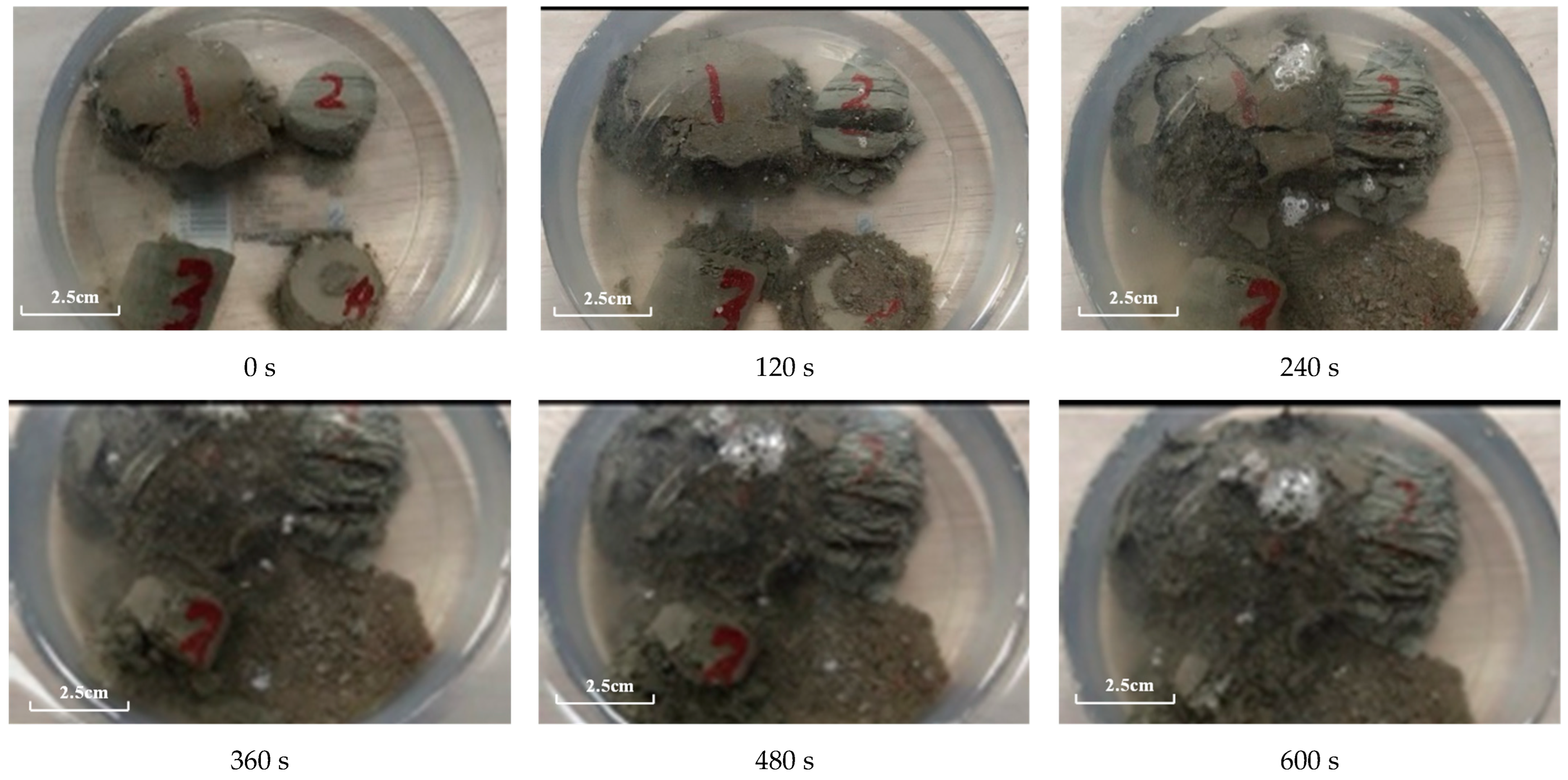

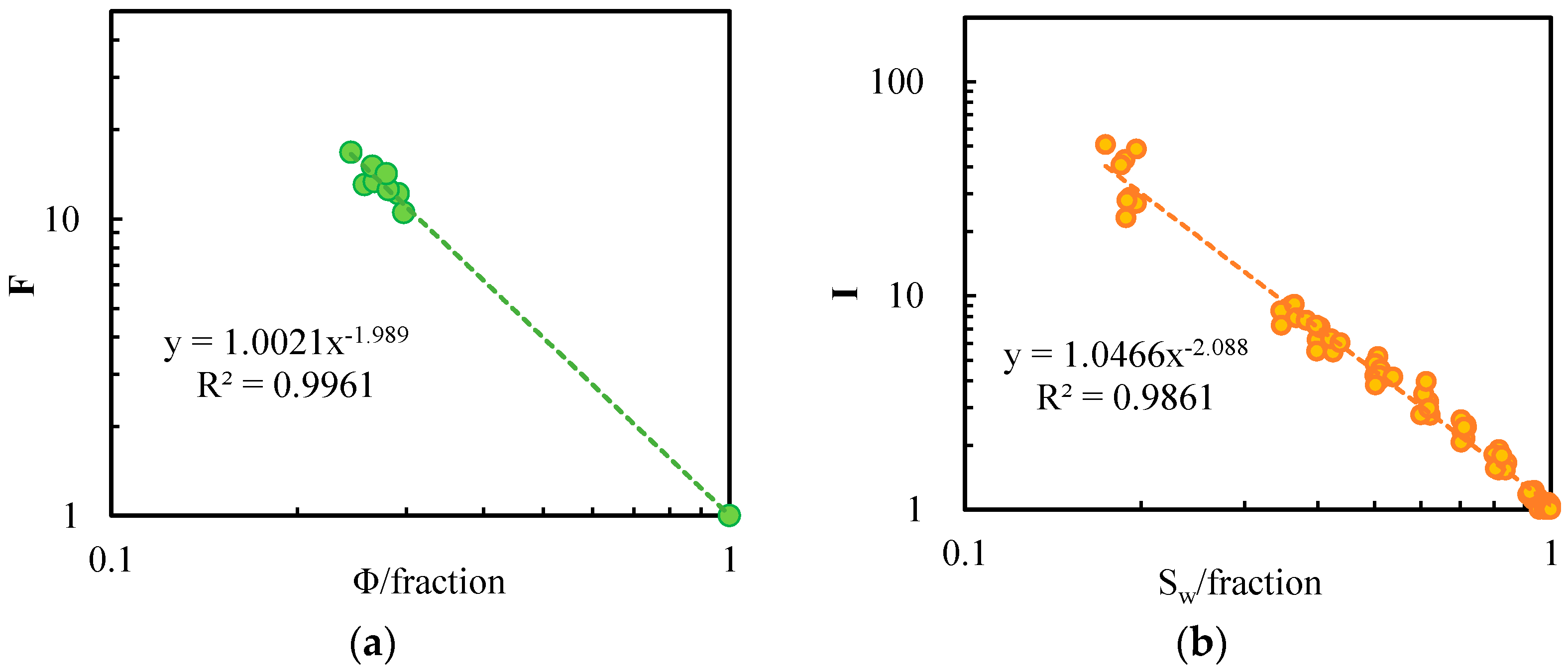

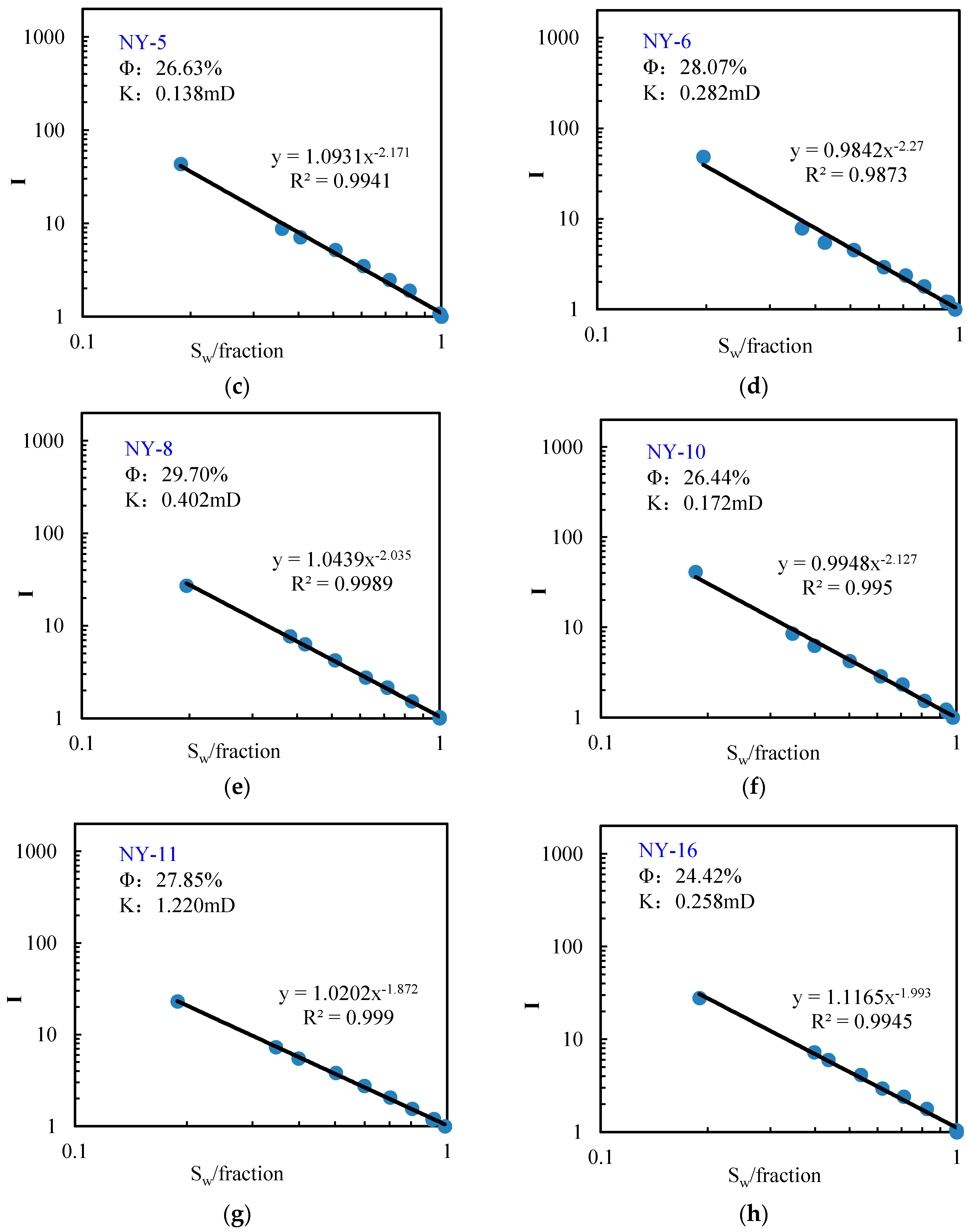
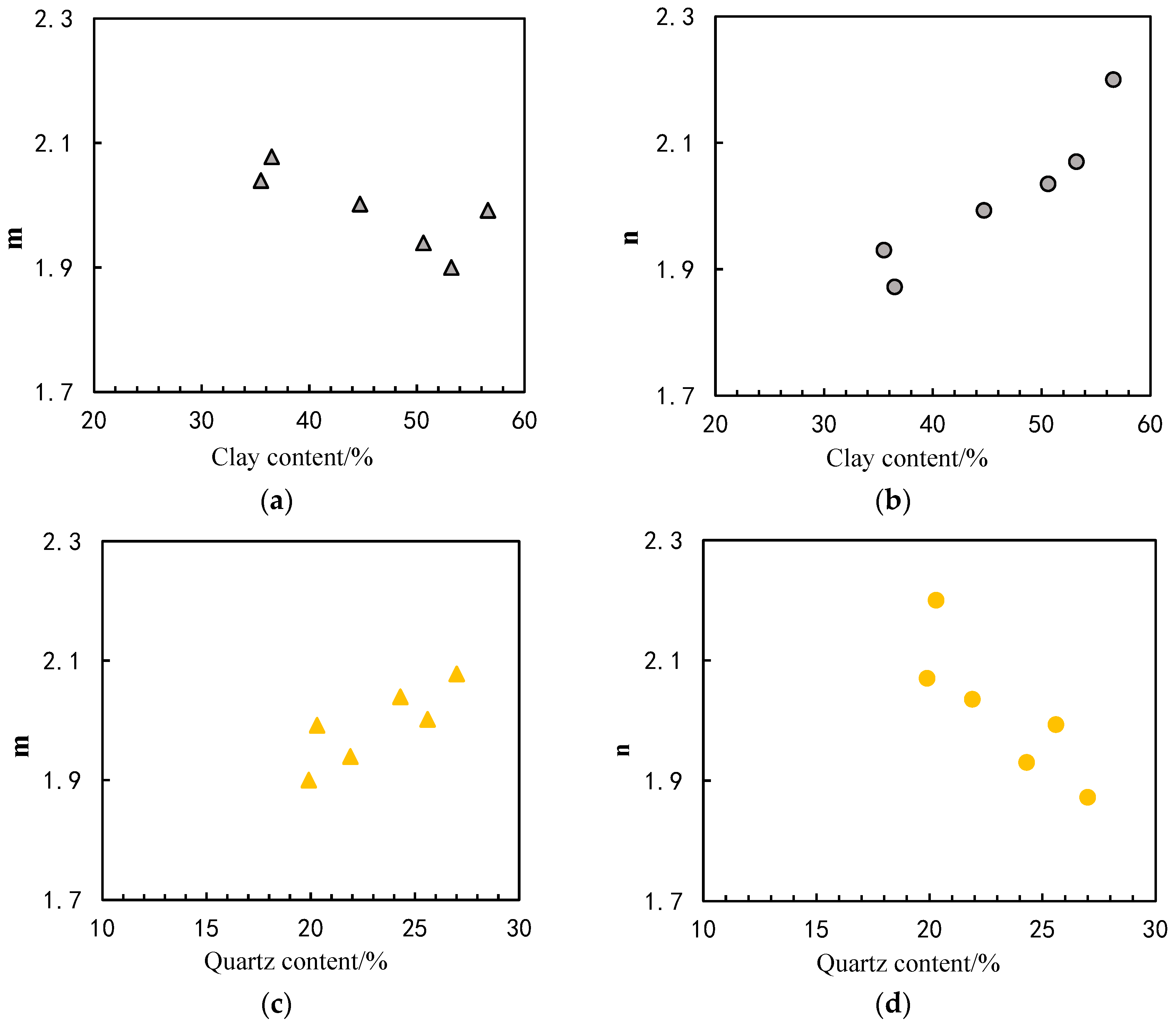
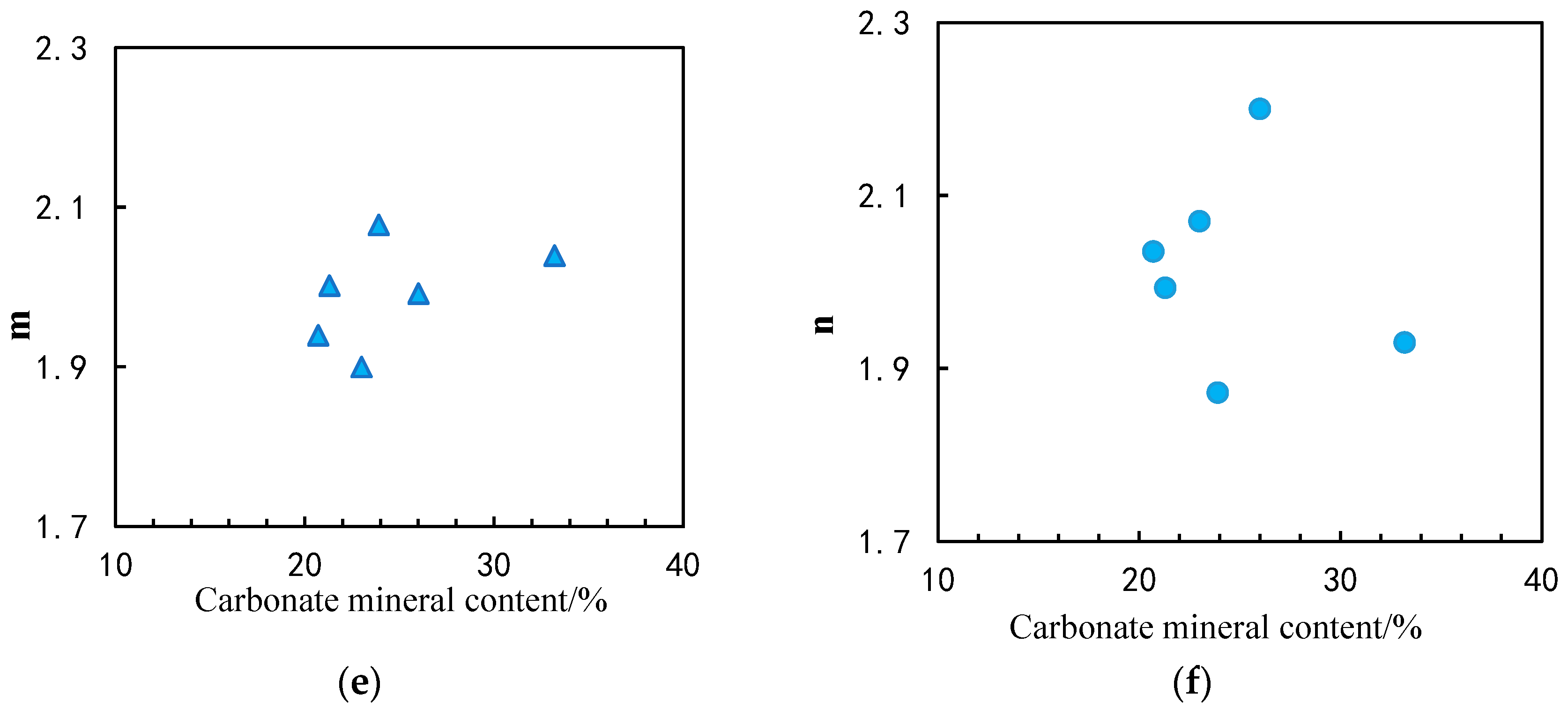
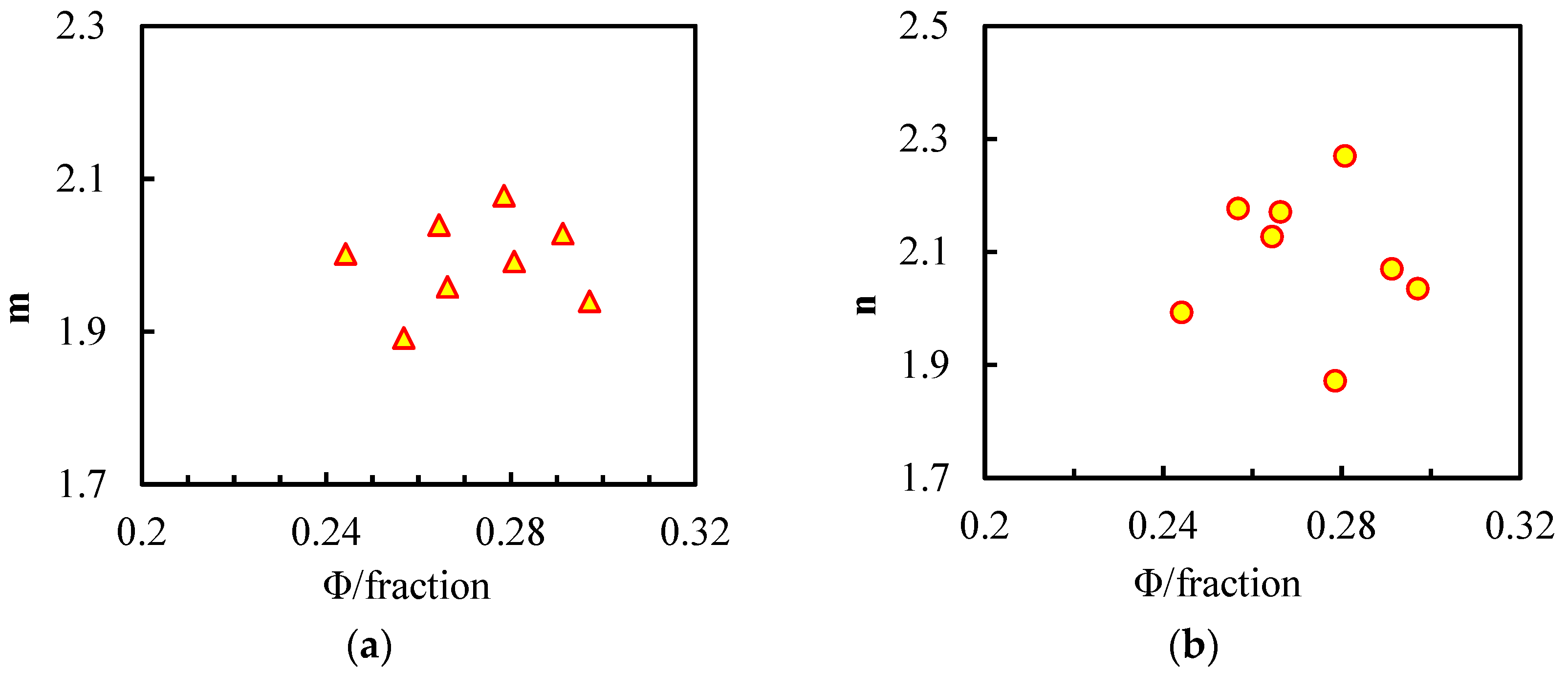
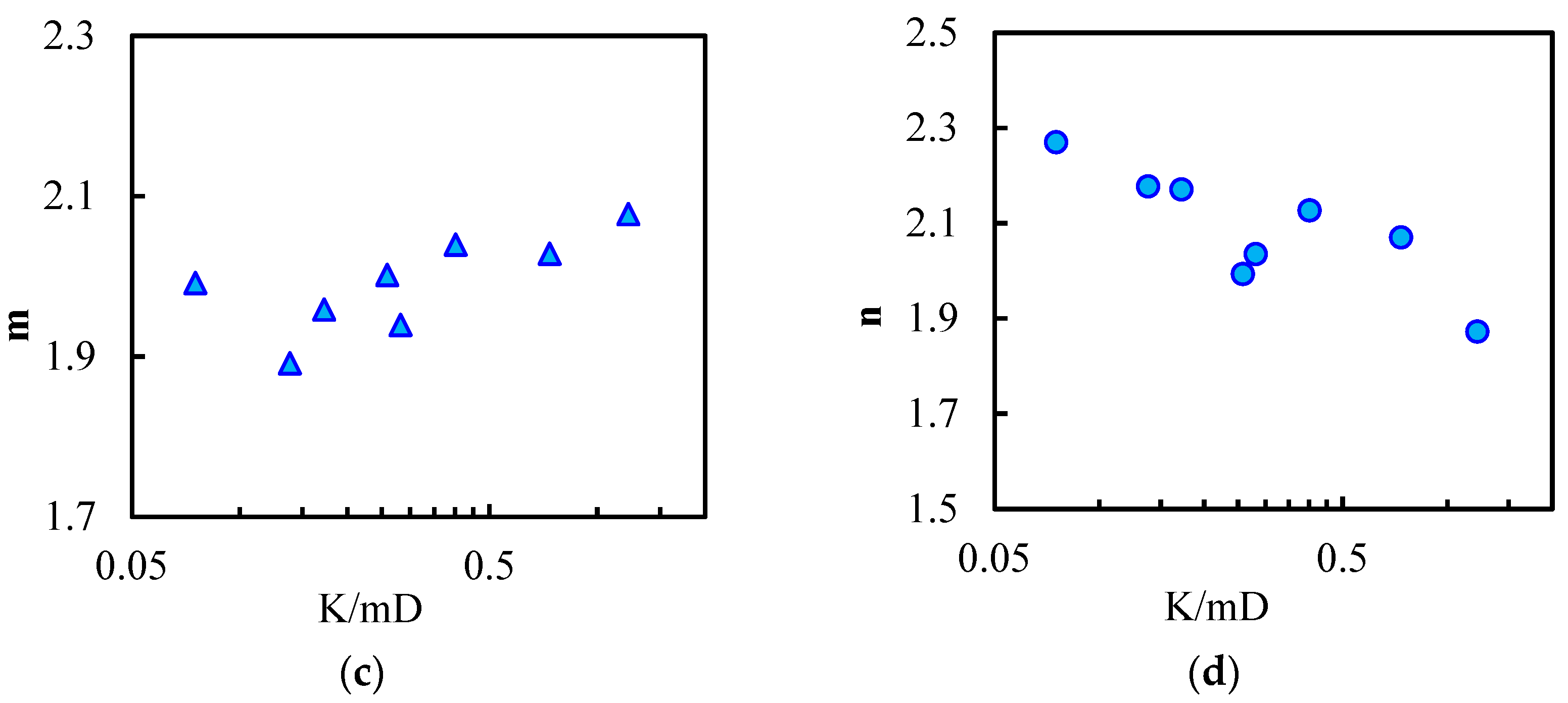
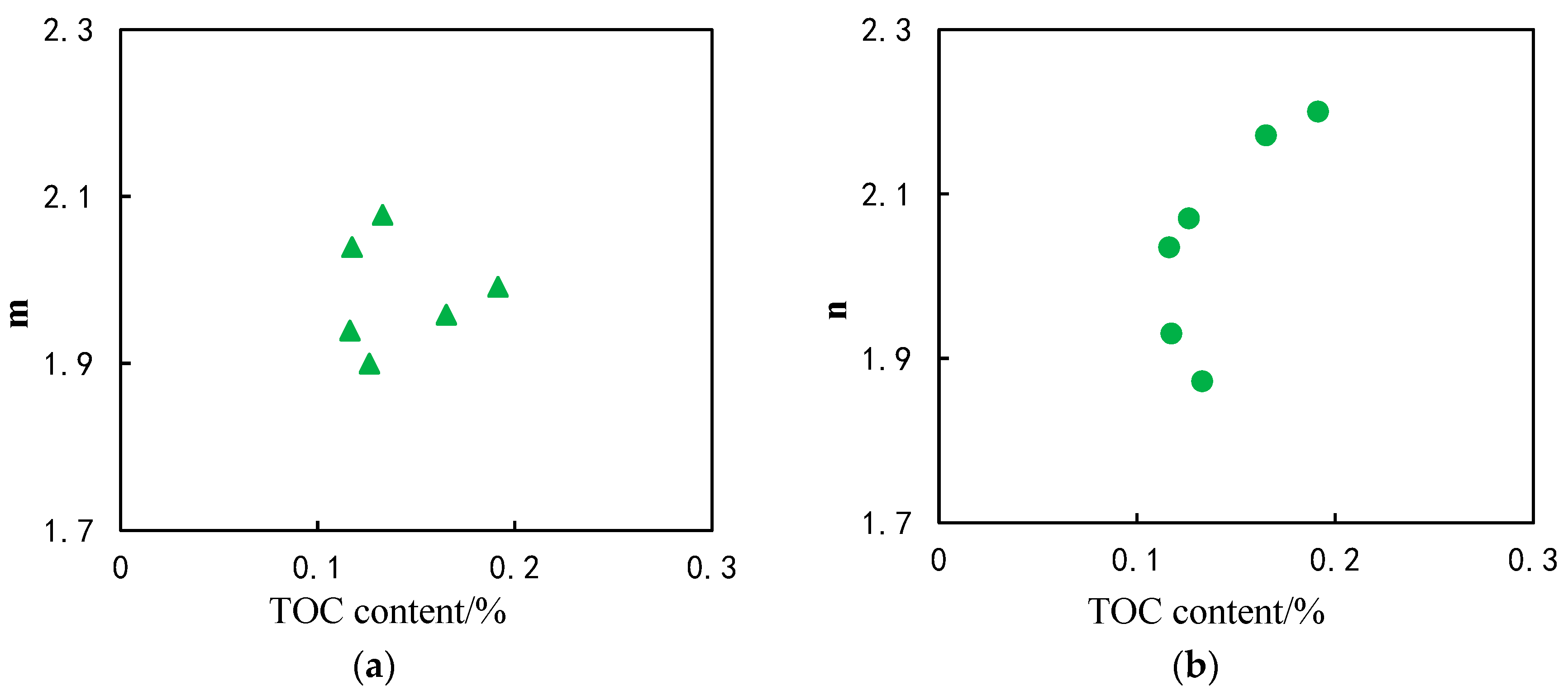
| Sample No. | Physical Property | VTOC/Fraction | Mineral Composition | Notes | ||||
|---|---|---|---|---|---|---|---|---|
| Φ/% | K/mD | Clay Content/% | Quartz Content/% | Carbonate Mineral Content/% | Others | |||
| NY-2 | 29.127 | 0.736 | 0.1262 | 53.2 | 19.9 | 23.0 | 3.9 | |
| NY-3 | 25.678 | 0.138 | / | / | / | / | / | No XRD analysis |
| NY-5 | 26.625 | 0.172 | 0.1652 | / | / | / | / | No XRD analysis |
| NY-6 | 28.071 | 0.075 | 0.1914 | 53.6 | 20.3 | 24.1 | 2.0 | |
| NY-8 | 29.704 | 0.282 | / | 50.6 | 21.9 | 20.7 | 6.8 | |
| NY-10 | 26.439 | 0.402 | 0.1174 | 35.5 | 24.3 | 33.2 | 7.0 | |
| NY-11 | 27.854 | 1.220 | 0.1329 | 36.5 | 27.0 | 23.9 | 12.6 | |
| NY-16 | 24.417 | 0.258 | 0.0618 | 44.7 | 25.6 | 21.3 | 8.4 | |
| Sample No. | Rock Electrical Parameters | ||
|---|---|---|---|
| F | m | n | |
| NY-2 | 12.207 | 2.03 | 2.07 |
| NY-3 | 13.085 | 1.89 | 2.18 |
| NY-5 | 13.355 | 1.96 | 2.17 |
| NY-6 | 12.559 | 1.99 | 2.27 |
| NY-8 | 10.352 | 1.94 | 2.04 |
| NY-10 | 15.079 | 2.04 | 2.13 |
| NY-11 | 14.238 | 2.08 | 1.87 |
| NY-16 | 16.816 | 2.00 | 1.99 |
Publisher’s Note: MDPI stays neutral with regard to jurisdictional claims in published maps and institutional affiliations. |
© 2022 by the authors. Licensee MDPI, Basel, Switzerland. This article is an open access article distributed under the terms and conditions of the Creative Commons Attribution (CC BY) license (https://creativecommons.org/licenses/by/4.0/).
Share and Cite
Liu, J.; Chai, X.; Yang, H.; Gu, D.; Wang, L. Measurement of Rock Electrical Parameters and Analysis of Influencing Factors of Quaternary Mudstone Biogas Reservoirs in Qaidam Basin. Energies 2022, 15, 9100. https://doi.org/10.3390/en15239100
Liu J, Chai X, Yang H, Gu D, Wang L. Measurement of Rock Electrical Parameters and Analysis of Influencing Factors of Quaternary Mudstone Biogas Reservoirs in Qaidam Basin. Energies. 2022; 15(23):9100. https://doi.org/10.3390/en15239100
Chicago/Turabian StyleLiu, Junfeng, Xiaoying Chai, Huijie Yang, Duanyang Gu, and Liang Wang. 2022. "Measurement of Rock Electrical Parameters and Analysis of Influencing Factors of Quaternary Mudstone Biogas Reservoirs in Qaidam Basin" Energies 15, no. 23: 9100. https://doi.org/10.3390/en15239100




